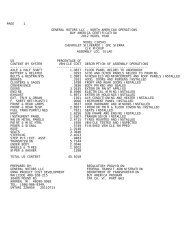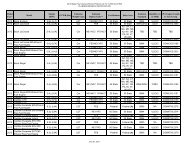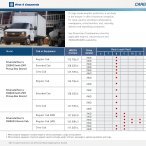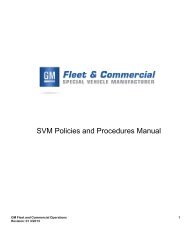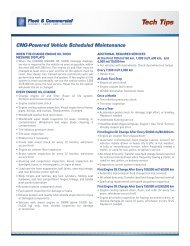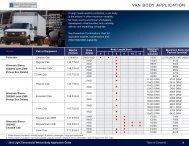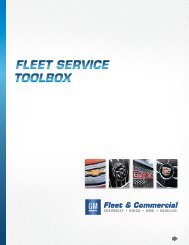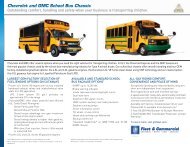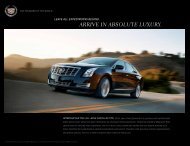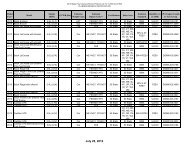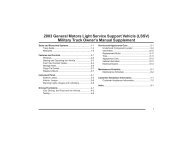2012 Chevrolet Police Technical Manual (pdf) - GM Fleet
2012 Chevrolet Police Technical Manual (pdf) - GM Fleet
2012 Chevrolet Police Technical Manual (pdf) - GM Fleet
Create successful ePaper yourself
Turn your PDF publications into a flip-book with our unique Google optimized e-Paper software.
16 | aNtI-Lock brakINg systEm aND stabILItrak<br />
a. Always maintain a safe<br />
following distance. ABS does not<br />
allow you to stop on a dime. (Generally a<br />
2-second following distance is considered<br />
safe in ideal conditions.) Watch the vehicle<br />
in front of you pass a fixed marker (such as a<br />
sign). Count seconds—one-thousand-one,<br />
one-thousand-two-until your front bumper<br />
reaches the marker. If you do not count out<br />
two seconds, then you are too close to the<br />
vehicle in front of you. Also, if the roads are<br />
wet or icy, or visibility is poor, you should<br />
increase your following distance.<br />
<strong>2012</strong> <strong>Chevrolet</strong> Municipal Vehicles <strong>Technical</strong> <strong>Manual</strong><br />
iMPoRtant<br />
DRivinG<br />
SaFEty tiPS<br />
b. Always drive carefully—<br />
especially on slippery surfaces. ABS cannot<br />
create friction between the tires and the road<br />
surface, it can only give the driver the<br />
maximum advantage of the existing<br />
adhesion. If the vehicle is traveling on a<br />
surface with no adhesion, the best ABS in the<br />
world cannot provide a shorter stopping<br />
distance or good steering.<br />
C. It is a good idea to practice an<br />
ABS activated stop and get the feel<br />
of the brake pedal. However, please make<br />
sure it’s at a safe time with no obstacles in<br />
your path. And you only really need to try<br />
it once or twice to know what happens.<br />
ELECtRoniC StabLiLity ConiRoL SyStEMS (StabiLitRak)<br />
StabiliTrak systems help drivers maintain control of their<br />
vehicles, especially during emergency lane changes or<br />
avoidance maneuvers. StabiliTrak uses various sensors,<br />
such as steering wheel angle, wheel speed, yaw velocity,<br />
etc., to detect any difference between the path requested<br />
by the steering wheel position and vehicle’s actual path.<br />
When appropriate, the system selectively controls brakes,<br />
engine power, and even suspension settings to enhance<br />
control of the vehicle’s direction and help keep it on course.<br />
Independent studies conducted by the National Highway<br />
Traffic Safety Administration, the Insurance Institute for<br />
Highway Safety, and others have found StabiliTrak to be<br />
highly effective in reducing vehicle crashes. General Motors<br />
offers StabiliTrak systems on many of its passenger car<br />
and light truck models.<br />
See your owner's manual for additional information about<br />
the operation of StabiliTrak.<br />
Q. How do I use StabiliTrak?<br />
A. StabiliTrak operates independently of the driver. You<br />
should continue to drive your StabiliTrak equipped<br />
vehicle with caution and care. <strong>GM</strong>’s StabiliTrak system,<br />
StabiliTrak, is designed to be as seamless as possible in<br />
operation, to be part of the overall vehicle response and to<br />
make a good vehicle better<br />
Q. How does StabiliTrak work?<br />
A. StabiliTrak has the ability to apply control forces to<br />
the vehicle independent of the driver. StabiliTrak uses<br />
sensors to continuously compare the path indicated by<br />
the steering wheel position to the vehicle’s actual path. If<br />
a discrepancy is detected, StabiliTrak selectively controls<br />
vehicle brakes and engine torque to create a yaw moment<br />
that helps restore the vehicle’s actual path to the path<br />
indicated by the steering wheel position. StabiliTrak has<br />
the ability to help correct both understeer (where the<br />
vehicle is not turning as much as the steering wheel<br />
position indicates) and oversteer (where the vehicle is<br />
turning more than the steering wheel position indicates).<br />
The illustration at right shows how selective braking at a<br />
particular wheel can create a compensating yaw moment<br />
to help restore the vehicle’s actual path to the path<br />
indicated by the steering wheel position.<br />
Q. Will a tire change affect StabiliTrak?<br />
A. Use of tires other than original equipment may affect<br />
StabiliTrak performance. StabiliTrak is designed to make<br />
the best use of available traction. The performance<br />
characteristics of the original equipment tires are part of<br />
the overall system effectiveness. When you replace tires<br />
check the recommendations in your Owners <strong>Manual</strong>. On<br />
<strong>GM</strong> vehicles, the original equipment tires have a “TPC”<br />
(Tire Performance Criteria) code on the sidewall. Replacing<br />
the tires with the same “TPC” code will help assure proper<br />
StabiliTrak performance.





